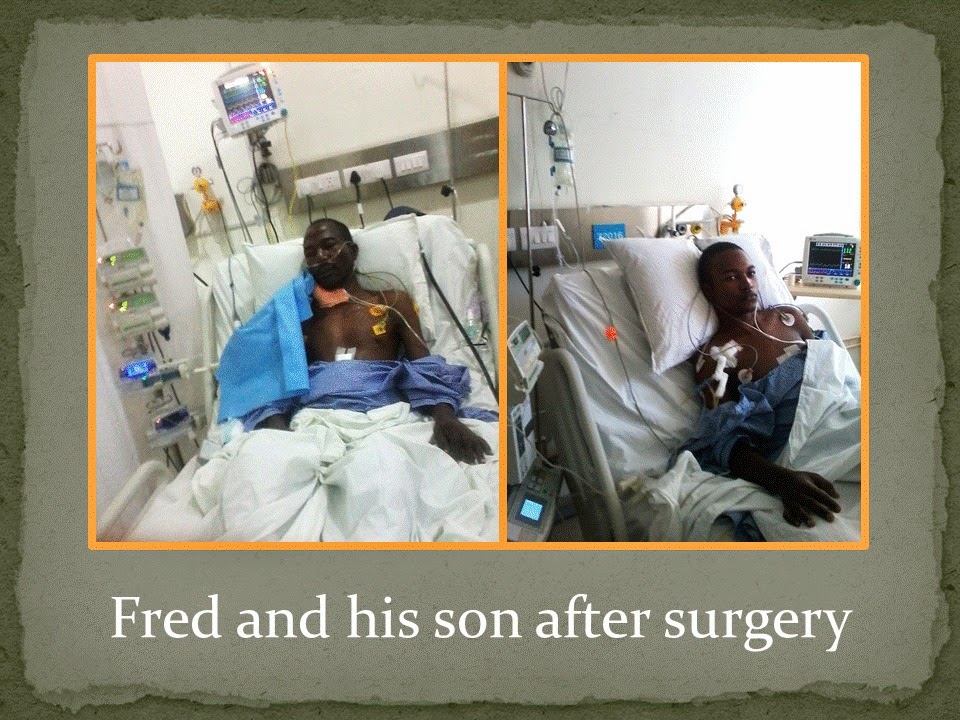Staying active and engaging in sports has been
Fredrick Kiyingi’s lifestyle since childhood.
However, as he grew older, his daily life was
affected so much that by 30, he could not partake in any physical activity.
He was 37 years old when a medical examination by
Prof Michael Kawooya, a senior radiologist at Mengo hospital revealed that his
gall bladder was releasing toxins into the liver. It was also on the verge of
rupturing.
Kiyingi, now 47, was born with a liver problem
medically termed as choledochal cyst.
Dr David Ndawula, the medical director of Kampala
Family Clinic says a choledochal cyst occurs when the bile duct, a vessel that
leads bile to the intestines from the liver, is structured abnormally.
“This causes bile to accumulate in the duct resulting
in duct damage and formation of a cyst (fluid-filled sac),” Dr Ndawula
explains.
He says that a liver transplant becomes necessary
when the liver has been damaged to the extent that it cannot perform its normal
functions. This is known as liver failure.
The liver is one of the largest organs in the
body. It produces bile necessary in digestion of fats, makes agents needed for
blood clotting, removes toxins from the blood stream and controls blood sugars,
among other functions.
“Although liver failure can be managed by
medication, this can sustain one in good health for a short while. A liver
transplant is the only cure for liver failure,” he says.
RUNNING
OUT OF STEAM
In 2001, an acute pain on the right side of his
abdomen became a bedfellow. It caused him severe loss of appetite and nausea.
“To keep the pain at bay, I devotedly relied on
drugs meant to cure peptic ulcers because doctors suspected I was suffering
from these,” said Kiyingi, the safety and security coordinator of US Peace
Corps - Uganda.
He used the drugs between 2002 and 2005.
But by May 2005, Kiyingi was starting to feel much
more tired. His body darkened and thinned so much that he suspected HIV.
“Once, I went to Kampala family clinic in Nsambya
to buy pain killers and told Dr Ndawula that I had HIV. He told me to open my
mouth and stick my tongue out and hinted on the possibility of a gall bladder
and liver complication,” the soft spoken father of two said.
He was referred to Prof Kawooya who treated him
immediately, noticing that the gall bladder was about to rupture.
Ruptures are most
commonly caused by an inflammation of the gallbladder. The most common causes
are gall stones. The initial symptom of a gallbladder rupture is a sudden onset
of sharp or severe pain.
Kiyingi was later
admitted at Case Clinic.
“I stayed at Case for
three months and while here, I had jaundice, fever, more pain and my skin got
darker,” he recalls.
Ndawula says jaundice
is caused by the liver’s failure to remove bilirubin, a brownish yellow
substance found in bile.
Kiyingi was operated
upon and his gall bladder, plagued with gall stones was removed together with a
fraction of the affected liver.
Dr Ndawula says a
portion of a liver can be removed because of the liver’s unique ability to
regenerate. It is the only organ in the body with this capability.
WORSE BECOMES WORST
Just two weeks after
the first operation, his stomach started swelling tremendously because the improvised
plastic bile duct was misdirected.
“Immediately, I was
rushed to Mengo hospital in an ambulance and about three litres of dark green
bile were drained from my body,” he reminisces.
A metallic tube was
inserted into his body to drain the excess bile and liver function tests showed
that his liver had completely deteriorated. He was thus linked to Prof Godfrey
Lule, a consultant physician and gastroenterologist at Nairobi hospital.
To raise money needed
for treatment in Nairobi, Kiyingi sold all his six cars and ended a transaction
meant to purchase a house.
At Nairobi hospital, a
magnetic resonance imaging (MRI) test revealed that Kiyingi’s liver was
completely rotten. He was now referred to Apollo hospital in India for further
treatment.
He arrived at the
hospital on December 24, 2013 and examinations revealed that he had liver
cirrhosis –an abnormal liver condition in which there is
irreversible scarring of the liver.
“The doctors here told me that I had only six
months to live unless I underwent a transplant for which I needed $60,000 and a
donor,” he says.
Fortunately his son, Laurin
Baalu, 18, was willing to part
with a portion of his liver.
THE
FINAL STRAW
He was operated upon on March 12 at the Health Care Global Enterprises in
Bangalore-India. He remained in the intensive care unit for two weeks and was
discharged on April 17.
Although Kiyingi has been down the hatches, he is one
of the few lucky ones; he is on the road to recovery. His chocolate skin complexion
is back and he has resumed work.
However, he is now on life medication and needs $
16,385 (about Shs 42m) to clear HCG’s hospital bill
For contribution, Kiyingi can be reached on
0776578667 or direct account deposits may be made to A/C no. 1100035091-Housing
Finance Bank or 6004149376-Barclays Bank.



